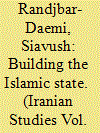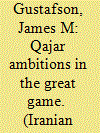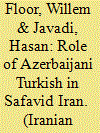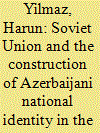|
|
|
Sort Order |
|
|
|
Items / Page
|
|
|
|
|
|
|
| Srl | Item |
| 1 |
ID:
128576


|
|
|
|
|
| Publication |
2013.
|
| Summary/Abstract |
The early drafts of the constitution of 1979 have represented a crucial moment in the creation of the post-revolutionary Iranian state. This article makes use of primary sources of the time and recently revealed material in order to provide a systematic analysis of the events which led to the production of the key versions of the draft constitution and the reaction to them by the multitude of political movements which were then active. The aim of this study is to clarify events and processes which have been left unexplored by the existing academic literature.
|
|
|
|
|
|
|
|
|
|
|
|
|
|
|
|
| 2 |
ID:
128567


|
|
|
|
|
| Publication |
2013.
|
| Summary/Abstract |
As an acclaimed work of twentieth-century Persian fiction, Sadeq Hedayat's The Blind Owl has stirred much scholarly contemplation. Identical characters obscure the work; the resemblance amongst them seemingly originates in some mysterious old man. The paper first demonstrates how every male character resembles this old man. Thereafter, he is argued to be non-existent; all the characters, therefore, become Baudrillardian simulacra bound together through family resemblances. A language-game is then fashioned to represent the family. The metamorphosis of the narrator is followed to manifest how this language-game haunts the characters-other language-games. The paper hopefully sheds some light on an ambiguous aspect of the work and provides a model as to how one language-game takes over another.
|
|
|
|
|
|
|
|
|
|
|
|
|
|
|
|
| 3 |
ID:
128575


|
|
|
|
|
| Publication |
2013.
|
| Summary/Abstract |
Recent research has found that discrimination against Islam and Muslims is deeply rooted in Australia. This report explores whether or how recent Iranian migrants have experienced racism, discrimination, or Islamaphobia in Sydney. These questions are explored by focusing on their experiences and issues regarding their making of new lives in Australia. This article suggests that recent Iranian migrants are experiencing far less discrimination than other Muslim diasporas in Sydney. Concluding that despite recent reports by some researchers grouping various Muslim populations together as regards Islamaphobia, there is a necessity for investigating discrimination, stereotyping, and Islamaphobia against particular diasporas to determine the needs of the Muslim population at large.
|
|
|
|
|
|
|
|
|
|
|
|
|
|
|
|
| 4 |
ID:
128570


|
|
|
|
|
| Publication |
2013.
|
| Summary/Abstract |
The figure of the martyred soldier is so ingrained in the Iranian public sphere that today, thirty years after the Revolution and twenty years after the cessation of the hostilities against Iraq, Iranian revolutionary painting on canvas keeps drawing most of its inspiration from the Shiite rhetoric of the martyred body and from the war. this article identifies and analyzes the iconographic forms of the martyred body in this pictorial production, which expresses primarily the concerns of the state. Relying on six works on canvas - painted before, during and thirty years after the Revolution - a scalable approach to the various representations of the martyred body is proposed, referring to Iran's history.
|
|
|
|
|
|
|
|
|
|
|
|
|
|
|
|
| 5 |
ID:
128572


|
|
|
|
|
| Publication |
2013.
|
| Summary/Abstract |
This essay details Leo Valiani's mission to Iran in 1952-53 on behalf of Mediobanca, in order to identify opportunities to promote investments for the development of both the country itself and Italian exports. The events are reconstructed through Valiani's correspondence with Enrico Cuccia (Mediobanca's CEO). A new picture of Valiani as banker emerges, effective on the ground, but also a subtle observer of local situations and prospects. The documents discussed herein highlight certain weaknesses in Mosaddeq's policies, mainly the weak relationship with the heads of finance. The oil dispute between Mosaddeq and the British and the coup orchestrated by the latter in collaboration with the Americans in order to bring down Mosaddeq's government complicated the picture so that every form of co-operation had to be postponed.
|
|
|
|
|
|
|
|
|
|
|
|
|
|
|
|
| 6 |
ID:
128566


|
|
|
|
|
| Publication |
2013.
|
| Summary/Abstract |
Literature on the Great Game presents a strong dichotomy between European aggressors and Oriental victims. However, Qajar Iran possessed its own forgotten imperial project in Central Asia, explored here through an 1844 travelogue published anonymously in Iran as Safarnameh-ye Bokhara. This text, whose author is identified here as Qajar statesman 'Abbas Qoli Khan, details a diplomatic exchange with the amir of Bokhara over the life and death of Rev. Joseph Wolff and the infamous disappearance of British agents Stoddart and Conolly. Notably, 'Abbas Qoli Khan pressed Qajar claims to Marv to the amir, utilizing a discourse of historical and cultural unity between Iran and Greater Khorasan, in contrast to that of difference and hierarchy common in Anglo-Russian imperial projects.
|
|
|
|
|
|
|
|
|
|
|
|
|
|
|
|
| 7 |
ID:
128569


|
|
|
|
|
| Publication |
2013.
|
| Summary/Abstract |
Turkic languages and dialects played a much more important role in Safavid Iran than is generally thought, while Azerbaijani Turkish in particular was widely spoken and written in Safavid Iran. It was not only the language of the court and the army, but it was also used in poetry, even by renowned poets who usually wrote in Persian. The Safavid shahs, many of whom wrote poetry in Turkish themselves, promoted its literary use. Also, Turkish was used in the court's official correspondence, for both internal and external affairs.
|
|
|
|
|
|
|
|
|
|
|
|
|
|
|
|
| 8 |
ID:
128565


|
|
|
|
|
| Publication |
2013.
|
| Summary/Abstract |
Although the titular nation of the Azerbaijan Soviet Socialist Republic was Turkic speaking and had strong cultural and historical ties with Iran, the Soviet regime constructed a national identity that was divorced from its Turkic and Iranian past. The current literature cannot provide the exact period when this construction was put forward and generally argues that the Azerbaijani identity was artificially created as part of a broader "divide-and-rule" policy that was applied to all the Turkic nations in the Soviet Union. However, this thesis by itself does not explain why this change from a Turkic identity to an Azerbaijani one happened seventeen years after the Bolsheviks assumed power in Baku, and its simple causation makes it sound more like a conspiracy theory, which had a certain popularity in the Cold War era, than a scholarly argument. By presenting a broader view, the paper explains why and when the national identity in Soviet Azerbaijan was altered from Turkic to Azerbaijani. It argues that there were many factors that induced the Bolsheviks to take this extraordinary step in 1937. In fact, the change in defining national identity in Azerbaijan was a result of a combination of developments in the 1930s in Turkey, Iran, Germany, and the Soviet Union. The article concludes that these developments left Soviet rulers no choice but to construct an independent Azerbaijani identity.
|
|
|
|
|
|
|
|
|
|
|
|
|
|
|
|
|
|
|
|
|